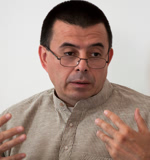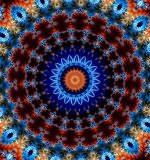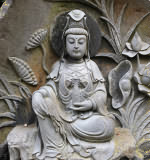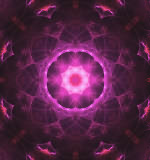| Töltsd le és telepítsd a nélkülözhetetlen betűtípusokat(s) Hogy megtekinthesd a Szanszkritot annak teljes fényében Olvass Transzliteráció (2) (magyar) hogy teljes mértékben átlásd a transzliterációs rendszert |
Tanulj Szanszkritul - Első Lépések (4)
A Szanszkrit ABC és a Teremtés szintjei - 1. rész
Introduction
Hi, Gabriel Pradīpaka again. This is the first of three documents that will deal with "Sanskrit Alphabet and the levels of Creation". The first two documents will contain the core of the teachings, while the third one will be a kind of summary in the form of an "appendix" (whose link to it will be placed in the respective section "Appendixes", of course). We are about to begin our study of Sanskrit Alphabet and the levels of Creation. There was a great master of Trika (Non-dual Shaivism of Kashmir), his name: Abhinavagupta. He was the author of such extraordinary works of spiritual wisdom as:
Tantrāloka, Īśvarapratyabhijñāvimarśinī, Īśvarapratyabhijñāvivṛtivimarśinī, Tantrasāra, Parātriṁśikāvivaraṇa, etc.
All these scriptures are a real treasure of knowledge.
His foremost disciple --Kṣemarāja-- continued to carry on the work of his revered master. He was the author of the celebrated Pratyabhijñāhṛdayam as well as Śivasūtravimarśinī. And precisely on that Śivasūtravimarśinī our present study is going to be focused. Śivasūtravimarśinī is by far the most complete commentary of the Śivasūtra-s (77 mysterious aphorisms that were passed on the sage Vasugupta directly by Śiva). Go to the document Trika 1 (English) for more information. Śivasūtra-s contain three sections which deal with Śāmbhavopāya, Śāktopāya and Āṇavopāya respectively. These "upāya-s" are "means" to advance in our spiritual path. Go to the documents of the Trika section for more information. Every person will begin his practice from one of those "upāya-s". Śāmbhavopāya is intended for "very advanced" seekers; Śāktopāya for "somewhat advanced" seekers; and Āṇavopāya for "average" seekers. Each of those sections has 22, 10 and 45 aphorisms respectively. Our study will be focused on the seventh aphorism of the second section (dealing with Śāktopāya). Despite this section is intended for "somewhat advanced" aspirants, the average seekers will have no problems with the aforesaid aphorism because the lucid explanation by Kṣemarāja together with my simple comments will do "the trick". Finally, I recommend you to read the Tattvic Chart and Tattva-s & Sanskrit when necessary, in order to grasp "completely" all teachings. In fact, reading "all" documents of Trika section (apart from "Tattvic Chart") will prove very useful indeed. I cannot explain "all" tattva-s or categories of Creation again because I risk collapsing!, haha! No, the real reason is that this document would be too long.
Important: All that is in brackets and italicized within the translation has been added by me in order to complete the sense of a particular phrase or sentence. In turn, all that is between double hyphen (--...--) constitutes clarifying further information also added by me, except when such double hyphens contain a translated word in red color.
Seventh aphorism of Section II (Śivasūtra-s)
Since the second section of Śivasūtra-s deals with Śāktopāya, it imparts teachings from Śakti's viewpoint. Śakti is the Universal Mother because "all" is coming from Her. That is why She is known as "Mātṛkā" or "little Mother". The suffix "kā" also gives the sense of "mysterious". Thus, the translation could be "mysterious Mother" as well. Besides, the word "Mātṛkā" means "letter". There is a close relationship between "Śakti" and the "letters". Śakti is the ultimate source of all letters which the entire alphabet is composed of. In turn, each single letter is "another" little mother on account of its bringing about infinite worlds. Note that a word is an aggregate of letters. For example: "fool". If someone calls you a "fool", your mind will be disturbed and anger or pain could arise in it. Maybe you will not be able to sleep next night because of that "simple" word and the innumerable worlds of thought manifested by it. That is what I meant to say by "on account of its bringing about infinite worlds".
You may wonder: "Kṣemarāja and this funny guy (me) will be commenting on just one aphorism throughout three long web pages?!!". Yes! One of the features of any "appropriate" aphorism is that it will produce a long commentary. An aphorism should be always very short and its commentary long. You do not believe me yet, do you? Well, the aphorism now (do not say that I did not warn you, haha!):
मातृकाचक्रसम्बोधः॥७॥
Mātṛkācakrasambodhaḥ||7||
(From a pleased Guru accrues) enlightenment (sambodhaḥ) regarding the group (cakra) of letters (mātṛkā)||7||
Because the commentary of Kṣemarāja is too long, I have split it into several paragraphs, which will spread throughout two web documents. As I said previously, the third document will be a summary of all that was taught in the first two ones.
Commentary by Kṣemarāja: Paragraphs 1, 2 and 3
I have divided the entire commentary of the sage into several paragraphs. In turn, I will split every paragraph into subparagraphs for the sake of convenience. My own commentary, in blue and black colors, will come after each of those subparagraphs. Besides, all phrases to be added to a particular sentence in order to complete the sense will appear in Italics as well as in brackets.
Kṣemarāja begins his sublime gloss with the following words:
शिष्यस्य भवतीति शेषः।
Śiṣyasya bhavatīti śeṣaḥ|
"Accrues (bhavati) to the disciple (śiṣyasya)"; this is the remaining part (iti śeṣaḥ) (of the aphorism)|
That is, you must add this phrase to the aphorism in order to indicate the recipient of that enlightenment. You will also have to add "From a pleased Guru" to the translation of the aphorism (sūtra) to complete the sense. The first paragraph is finished. Kṣemarāja continues to say:
श्रीपरात्रिंशकादिनिर्दिष्टनीत्याहंविमर्शप्रथमकलानुत्तराकुलस्वरूपा...
Śrīparātriṁśakādinirdiṣṭanītyāhaṁvimarśaprathamakalānuttarākulasvarūpā...
According to the process (nītyā) indicated (nirdiṣṭa) in venerable (scriptures) (śrī) Parātriṁśaka (parātriṁśaka), etc. (ādi), Anuttarākula (anuttarākula) is the essential nature (sva-rūpā) of the first (prathama) aspect (kalā) of I-Consciousness (ahaṁvimarśa)...
Note that Kṣemarāja is basing his first statement on such sublime scriptures as "Parātriṁśaka, etc.". This is real humbleness on his part. Thus, he is meaning to say that the commentary is not his own invention but a teaching that has been passed on him by his guru (Abhinavagupta).
"Kula" is that state in which Śiva and Śakti ("I" and "am" respectively) remain in indistinguishable unity. So, the first translation of "Akula" would be "a state different from Kula". In turn, this might mean two things: (1) a state in which Śiva and Śakti do not remain in indistinguishable unity; or else (2) a state completely distinct from that of Kula. In sum, "Akula" is the supreme condition of Consciousness or Śiva. In "Akula", there is no trace of "Śakti" at all. A second translation of "Akula" might be based upon the following reasoning: "Akula" = "A-kula". In this case, "kula" should be translated as "body". Thus, "Akula" would come to mean: "That whose body is the vowel 'a'". As you see, the subject is really deep.
The term "Anuttara" has two meanings: (1) "higher than which there is nothing", i.e. "the highest, supreme, etc.". Obviously, both of translations means the same thing. Therefore, the word "Anuttarākula" (Anuttara-akula) would mean: "That Supreme Reality whose body is the vowel 'a'". (2) A technical name for the vowel "a". So, the translation of "Anuttarākula" would be as follows: "That whose body is the vowel 'a', which is known as Anuttara".
The vowel "a" is Cit or Śiva Himself. It is pure Consciousness and the highest letter in the entire Sanskrit Alphabet. From "a" the whole universe is manifested. In short, the first aspect adopted by the Supreme Power is "a" --the state or condition of Śiva, the Eternal Subject who becomes a witness to all when the universe is set forth--. However, in His purest nature, "a" is only Consciousness.
... प्रसरन्त्यानन्दस्वरूपा सतीच्छेशनभूमिकाभासनपुरःसरं ज्ञानात्मिकामुन्मेषदशां ज्ञेयाभासासूत्रणाधिक्येन चोनतां प्रदर्श्य...
... prasarantyānandasvarūpā satīccheśanabhūmikābhāsanapuraḥsaraṁ jñānātmikāmunmeṣadaśāṁ jñeyābhāsāsutreṇādhikyena conatāṁ pradarśya...
... (Then, this first aspect of I-Consciousness, that is, pure Śakti,) is expanded (prasarantī... satī) in the form of (sva-rūpā) Ānanda (vowel "ā") (ānanda), and by means of (puraḥsaram) Her Manifesting Power (ābhāsana) --which appears as the stages (bhūmikā) of Icchā (vowel "i") (icchā) and Īśana (vowel "ī") (īśana)-- displays (pradarśya) the state (daśām) of Unmeṣa (vowel "u") (unmeṣa) whose essence (ātmikām) is Jñāna (jñāna). And (ca) through Her Opulence (ādhikyena), which is the origin (āsūtreṇa) of the sparkling manifestation (ābhāsā) of objects (jñeya), (that very pure Śakti brings) Ūnatā (vowel "ū") (ūnatām) (into existence)...
A concise but complete description of how vowels "ā, i, ī, u and ū" are all born from "a" or Anuttara. After playing the role of vowel "a", this first aspect of I-Consciousness is expanded as the vowel "ā", which is Supreme Bliss or Ānanda (hence its name). "A" and "ā" are Śiva and Śakti (Prakāśa and Vimarśa, "I" and "Am"). At this level the universe still has not been manifested. There is only a slight "stress" on the Formless Ocean of "a" (Śiva). This stress takes on the form of "ā". Note that "ā" is really "a" doubled. So, "ā" (Śakti) is a kind of expansion of "a" (Śiva). Got the point? Great!
But, at some point that "stress" ("ā") is transformed into "i" (Icchā) and "ī" (Īśana). "Icchā" means "Will" and "Īśana" "Mastery or Domination". Both of vowels belongs to the third tattva or category of Creation, i.e., Sadāśiva (tattva or category 3 according to Trika). Both of letters are the embodiment of Icchāśakti (Supreme Power of Will), but each of them is born from a different state of that very Icchāśakti. The Supreme Power of Will has a twofold nature in the form of "kṣubdha" and "akṣubdha". "What the heck is this?", you may wonder... well it is simple... the explanation would fill up several volumes, haha! I try to laugh all the time in the face of such huge ocean as Sanskrit, Trika and the rest of this great culture. Thus, I feel optimist... just a little.
The Power of Will has two aspects: Kṣubdha (agitated) and Akṣubdha (unagitated). When Icchāśakti (Power of Will) wants to manifest a universe, She is at first unaffected by it. This condition of universal manifestation along with unaffectedness in respect of the universe which has been created is known as "Akṣubdha" (unagitated) state. In turn, Kṣubdha condition is characterized by a state of affectation in respect of that very universe. So, the vowel "i" is Akṣubdhecchāśakti (Power of Will in a unagitated condition) while "ī" is Kṣubdhecchāśakti (Power of Will in an agitated condition). These two vowels representing the Manifesting Power of that pure Śakti give rise to two more vowels: "u" (Unmeṣa or Opening of the eyes) and "ū" (Ūnatā or Diminution).
The vowels "u" and "ū" are full of Jñānaśakti or Supreme Power of Knowledge. Just as Icchāśakti had two conditions (unagitated and agitated), so Jñānaśakti has two respective states too: Kṣubdha and Akṣubdha. In Kṣubdha condition Jñānaśakti is affected by the universe in which She is operating as the Power of Knowledge, while in Akṣubdha condition She is not. When She is not affected there is full "Opening of the eyes" (Unmeṣa), that is, You (Śiva) are completely conscious of both your own essential nature and that of the universe. There is "unfoldment" of true knowledge regarding both You and the universe. The body or kula of that Akṣubdhajñānaśakti (Power of Knowledge in a unagitated condition) is "u". Likewise, "ū" is the kula or body of Kṣubdhajñānaśakti (Power of Knowledge in an agitated condition), in which there is a deficiency or diminution of the knowledge. This decline of knowledge makes Śiva (You) feel affected by the distinct and sharp universe manifested in front of Him by His own Powers (Icchāśakti and Jñānaśakti).
(Go to Trika section and read the documents there in order to understand all in a proper manner. You will find very useful examples on those documents.)
For example, in your visual field Icchāśakti and Jñānaśakti are fully operative. Look at the corners of your own eyes and you will find Icchāśakti (Power of Will) there. She assumes two states: Akṣubdha and Kṣubdha (unagitated and agitated respectively). If you concentrate your attention on the corners of your eyes, you will gradually enter a state of unaffectedness in respect of that "indistinct and foggy" universe which is being born there. However, just before entering you will feel "affectation" yet. Still, this affectation is "subtle" and not the "gross" and well-known affectation that everybody experiences. These are the aforesaid Akṣubdha and Kṣubdha conditions of the Power of Will. Each of these two states has a "kula" or body. The vowel "i" (known as "Icchā" or "Will") is the kula of Akṣubdha condition, while "ī" (known as "Īśana" or "Mastery") is the kula of Kṣubdha condition.
And now, pay attention to the "distinct and sharp" universe just in front of you. The "external" sharpness in the objects and the corresponding "inner" knowledge which arises within you are due to the work of Jñānaśakti or Power of Knowledge. Note that you can feel "affected" or "unaffected" regarding those "distinct" objects. However, this affectation is "subtle" and not the "gross" and well-known affectation that everybody experiences. These two states are Akṣubdha and Kṣubdha conditions of the Power of Knowledge. Each of these two states has a "kula" or body. The vowel "u" (known as "Unmeṣa" or "Opening of the eyes") is the kula of Akṣubdha condition, while "ū" (known as "Ūnatā" or "Diminution") is the kula of Kṣubdha condition. So, you can easily infer that "u" and "ū" work at the level of Īśvaratattva (tattva or category 4 according to Trika).
The "omnipresent" question about "why should Śiva manifest a universe if He is fully blissful in His own essential nature?" has three logical responses: (1) Since You are Śiva Himself, it would be quite logical if you ask Yourself about it. However, if you cannot grasp this yet, the following two answers could be helpful: (2) Śiva is not conscious of any universe having emerged from Him. If you could ask Him about this topic, He would probably say: "What are you talking about? Where is that universe you are referring to?" And if you are still not fully convinced by the previous responses, there is a third one: (3) For Pure Self or Śiva to be called "Supreme", there must be "something" regarding which to unfold "Supremacy". Thus, the universal manifestation is not looked upon "a contraction or involution" of Śiva but "a reaffirmation" of His Sovereignty. Interesting! As you see, there is one response according to the level of consciousness of the person asking the question. This is a common characteristic in Trika. Even though this philosophical system gives more importance to the "non dualistic" viewpoint in the form of "I am Śiva", it comprises all other points of view too.
Well, I hope your intellect is still in one piece, haha! I tell you again: Go to Trika section and read all documents there. This will prove very useful for you. The sage Kṣemarāja continues his gloss in this way:
... इच्छामेव द्विरूपां विद्युद्विद्योतनकल्पतेजोमात्ररूपेण स्थैर्यात्मना चैषणीयेन रञ्जितत्वाद्रलश्रुत्यारूषितेनात एव स्वप्रकाशात्मीकृतमेयाभासत्वतोऽमृतरूपेण मेयाभासारूषणमात्रतश्च बीजान्तरप्रसवासमर्थतया षण्ढाख्यबीजचतुष्टयात्मना रूपेण प्रपञ्च्य...
... icchāmeva dvirūpāṁ vidyudvidyotanakalpatejomātrarūpeṇa sthairyātmanā caiṣanīyena rañjitatvādralaśrutyārūṣitenāta eva svaprakāśātmīkṛtameyābhāsatvato'mṛtarūpeṇa meyābhāsārūṣaṇamātrataśca bījāntaraprasavāsamarthatayā ṣaṇḍḥākhyabījacatuṣṭayātmanā rūpeṇa prapañcya...
... (Next, this very Śakti) manifests (prapañcya) the Will (icchām eva) --which has two (dvi) forms (rūpām) (i.e. "i" and "ī")-- combined with that which is merely (mātrarūpeṇa) a "light" (tejas) similar to (kalpa) the flash (vidyotana) of a lightning (vidyut) (i.e. the element "fire" whose body or kula is "r". She) also (ca) (manifests Icchā or Will) combined with that whose nature (ātmanā... eṣanīyena) is firmness (sthairya) (i.e. the element "earth" whose body or kula is "l". From these combinations, the vowels "ṛ, ṝ, ḷ and ḹ" arise. These vowels are not really produced letters but heard sounds) because they are (merely) colored (rañjitatvāt) or tinted (ārūṣitena) by the sounds (śrutyā) "ra" (ra) (and) "la" (la) (i.e. by the letters of fire and earth respectively; note that "ra" is simply "r" --seed letter-- plus "a", and "la" is "l" --seed letter-- plus "a". Not only) because of what was stated in the previous sentence (atas eva), but also inasmuch as (the vowels ṛ, ṝ, ḷ and ḹ) appear (ābhāsatvataḥ) as (subtle) objects (meya) assimilated (ātmīkṛta) to their own (sva) light (prakāśa), they are known as Imperishable (letters) (amṛtarūpeṇa). And (ca) since they are merely (mātrataḥ) tinted (ārūṣaṇa) by the objective (meya) manifestation (ābhāsa), they are not able (asamarthatayā) to give rise (prasava) to other (antara) seed letters (bīja). (As a result,) this group of four (catuṣṭayātmanā rūpeṇa) seed letters (bīja) is designated (ākhya) Eunuch (ṣaṇḍḥa)...
After appearing in the form of "a, ā, i, ī, u and ū", pure Śakti combines the vowels "i" and "ī" with the seed letters of the fire and earth elements: "ra" and "la" respectively, which are actually "r + a" and "l + a". From these combinations, the vowels "ṛ, ṝ, ḷ and ḹ" emerge. Will as "i" is combined with "r" and "l", which brings about "ṛ" and "ḷ". Afterward, Will as "ī" is combined with the same "r" and "l" to generate "ṝ" and "ḹ" . Some authors compare these two phases of combination performed by Will ("i" + "r" and "l", and then "ī" + "r" and "l") to the process through which the flash of a lightning is firstly a mere faint glimmer, but ultimately it becomes a bright light. Thus, Will is at first combined as "i" and then as "ī". Note that "ī" is simply "i" doubled or strengthened, just as the final bright light of a lightning is simply a strengthening of that pristine faint glimmer. Exquisite analogy indeed.
Maybe you are wondering: "What does the phrase '...(the vowels ṛ, ṝ, ḷ and ḹ) appear as (subtle) objects assimilated to their own light...' mean?" The answer is as follows: Inasmuch as those four vowels remain in themselves, without producing any other letter, they are said to be subtle objects assimilated to their own light. They are Amṛta (Imperishable) letters and live in Sadāśiva (tattva or category 3) along with "i and ī". They are also known as Ṣaṇḍḥa (eunuchs) letters. There two reasons for this:
(1) The letters ṛ, ṝ, ḷ and ḹ are neither purely vowels nor purely consonants. They have a vowel ("i" or "ī") and a consonant ("r" or "l") within themselves. In short: ṛ = "r" + "i", ṝ = "r" + "ī", ḷ = "l" + "i" and ḹ = "l" + "ī".
(2) They are unable to give rise to any other letter.
The abode of these vowels ṛ, ṝ, ḷ and ḹ is the indistinct and foggy Sadāśiva (tattva 3). They are full of "creative" Will but since they are merely "colored" by the manifested universe (objective manifestation), they do not participate in the creation of any other letter and, obviously, they have no meddling in the manifestation of the universe itself either, which is "entirely" produced by the rest of letters.
Kṣemarāja continues to comment:
... प्रोक्तानुत्तरानन्देच्छासङ्घट्टेन त्रिकोणबीजमनुत्तरानन्दोन्मेषयोजनया च क्रियाशक्त्युपगमरूपमोकारं प्रोक्तैतद्बीजद्वयसङ्घट्टेन षट्कोणं शूलबीजं चेच्छाज्ञानशक्तिव्याप्तपूर्णक्रियाशक्तिप्रधानत्वाच्छक्तित्रयसङ्घट्टनमयं प्रदर्श्य...
... proktānuttarānandecchāsaṅghaṭṭena trikoṇabījamanuttarānandonmeṣayojanayā ca kriyāśaktyupagamarūpamokāraṁ proktaitadbījadvayasaṅghaṭṭena ṣaṭkoṇaṁ śūlabījaṁ cecchājñānaśaktivyāptapūrṇakriyāśaktipradhānatvācchaktitrayasaṅghaṭṭanamayaṁ pradarśya...
... (After that, Śakti) manifests the seed letter (bījam) Trikoṇa --i.e. the vowel "e"-- (tri-koṇa) by means of the combination (saṅghaṭṭena) of Icchā --i.e. "i"-- (icchā) with Anuttara --i.e. "a"-- (anuttara) and Ānanda --i.e. "ā"-- (ānanda), which were previously referred to (prokta). And (ca) through the union (yojanayā) of Unmeṣa --i.e. "u"-- (unmeṣa) with Anuttara --i.e. "a"-- (anuttara) and Ānanda --i.e. "ā"-- (ānanda), (She manifests) the letter (kāram) "o" (o), whose nature (rūpam) indicates (upagama) (the appearance of) Kriyāśakti (kriyā-śakti). (Afterward,) by combining (saṅghaṭṭena) these (etad) aforesaid (prokta) groups formed from two (dvaya) seed letters (bīja), --i.e. the groups "a-ā" and "e-o"--, (Śakti) manifests (pradarśya) Ṣaṭkoṇa --i.e. the vowel "ai"-- (ṣaṭkoṇam) and (ca) the seed letter (bījam) Śūla --i.e. the vowel "au"-- (śūla). Because (in the letter "au") there is predominance (pradhānatvāt) of Kriyāśakti (kriyā-śakti) --at its height-- (pūrṇa) pervaded (vyāpta) by Icchāśakti and Jñānaśakti (icchā-jñāna-śakti), (the Goddess manifests that letter) as composed (mayam) of the union or combination (saṅghaṭṭana) of the three (traya) (abovementioned) śakti-s (śakti) (i.e. Icchā, Jñāna and Kriyā)...
The letter Trikoṇa or "triangular" is "e", which is formed from the combination of "i" (Icchā or Will) with "a" (Anuttara or the Supreme letter) and "ā" (Ānanda or Bliss). As a matter of fact, these two last vowels ("a" and "ā") are merely two aspects of only one Reality. Śiva and Śakti are one. In turn, the letter "o" is built up from the combination of "u" (Unmeṣa or Opening of the eyes) with both "a" and "ā". Although Kṣemarāja declares that, with good reason, the vowel "o" marks the appearance of Kriyāśakti, the vowel "e" is also one of the four aspects of that very Kriyāśakti or Power of Action. The four aspects are, obviously: "e", "o", "ai" and "au"... but let us advance slowly in our study.
The two remaining aspects of Kriyāśakti (Power of Action) are formed from different combinations:
(1) The Ṣaṭkoṇa or Hexagonal letter is "ai". This vowel is constructed by joining "a"/"ā" and "e" together.
(2) The Śūla or Triśūla letter (Trident) is "au". This vowel is constructed by joining "a"/"ā" and "o" together.
You may wonder, "Why are those letters called Trikoṇa, Ṣaṭkoṇa and Triśūla respectively?" If you examine the Sanskrit characters for "e" y "ai" (Go to Sanskrit Alphabet), you will not find any triangular or hexagonal features in them. And you will not find any resemblance between the character for "au" and a trident at all. The reason for this is that those names were assigned to "e", "ai" and "au" due to other reasons. Listen to me:
The vowel "e" is known as "Trikoṇa" letter because (1) it is written as "ñ" in Śāradā script (a particular writing of Kashmir), and because (2) the three śakti-s of Icchā, Jñāna and Kriyā participate in its formation.
The vowel "ai" is known as "Ṣaṭkoṇa" letter because the corresponding character in Śāradā script contains six angles.
Finally, the vowel "au" is known as "Triśūla" letter because even though the three śakti-s of Icchā, Jñāna and Kriyā are also present in "e", "ai" and "o", is in "au" where the aforesaid triad of powers (Will, Knowledge and Action) achieves accomplishment. That is why "au" is designated "Trident" letter. Well, the next portion of the text now to finish the first paragraph of Kṣemarāja's commentary :
... इयत्पर्यन्तविश्वैकवेदनरूपं बिन्दुमुन्मील्य युगपदन्तर्बहिर्विसर्जनमयबिन्दुद्वयात्मानं विसर्गभूमिमुद्दर्शितवत्यत एवान्तर्विमर्शनेनानुत्तर एवैतद्विश्वं विश्रान्तं दर्शयति बहिर्विमर्शेन तु कादिमान्तं पञ्चकपञ्चकम् अ-इ-उ-ऋ-ऌ-शक्तिभ्यः पुरुषान्तं समस्तं प्रपञ्चयति।...
... iyatparyantaviśvaikavedanarūpaṁ bindumunmīlya yugapadantarbahirvisarjanamayabindudvayātmānaṁ visargabhūmimuddarśitavatyata evāntarvimarśenānuttara evaitadviśvaṁ viśrāntaṁ darśayati bahirvimarśena tu kādimāntaṁpañcakapañcakam a-i-u-ṛ-ḷ-śaktibhyaḥ puruṣāntaṁ samastaṁ prapañcayati|...
... (Following, Śakti) displays (unmīlya) Bindu (bindum), whose nature (saṅghaṭṭena) is a undivided (eka) Knowledge (vedana) of the universe (viśva), to its very frontiers (indeed) (iyatparyanta). (Afterward, this Śakti) shows (uddarśitavatī) the stage (bhūmim) of Visarga (visarga) consisting (ātmānam) in a couple (dvaya) points (bindu) which are full (maya) of simultaneous (yugapad) outward (bahis) (and) inward (antar) emission (visarjana). (So,) because of all this (which has been mentioned) (atas eva), (the Supreme Goddess) --through (Her) inner (antar) Awareness (vimarśanena)-- shows (darśayati) this (etad) universe (viśvam) as resting (viśrāntam) only (eva) on Anuttara --i.e. the vowel "a"-- (anuttaraḥ); but (tu) by means of (Her) outer (bahis) Awareness (vimarśena), (She) manifests (prapañcayati) --through the śakti-s or powers (śaktibhyaḥ) a-i-u-ṛ-ḷ (a-i-u-ṛ-ḷ)-- five groups (pañcakam) of five letters (each) (pañcaka) --beginning (ādi) with the letter "ka" (ka) and ending (antam) in the letter "ma" (ma)-- as an aggregate (samastam) (of five groups formed from five tattva-s or categories each) --(starting with tattva 36 or earth element) and ending (antam) in Puruṣa --tattva 12-- (puruṣa)--|...
The word "Bindu" (or "Vindu") means both "knower" (from the root "vid" -- to know--) and "dot". Bindu is the philosophical name of Anusvāra (ṁ). It denotes that despite all this manifestation consisting of innumerable names and forms, the Supreme Knower (You) remains the Highest Knower, that is, He is an eternal detached Witness to all that is manifested by His own Power or Śakti. As I said previously, in the Sanskrit alphabet Bindu is represented by "ṁ" (Anusvāra). However, on account of its being impossible to be pronounced without any vowel before, "a" is added to it. Thus, in the alphabet you find "aṁ -- अं" (the dot above is Anusvāra or Bindu). In fact, the term "Anusvāra" means "coming after a vowel", that is to say, it needs a vowel to be pronounced. Bindu is directly related to tattva 4 (Īśvara) in which Jñānaśakti (Power of Knowledge) is predominant.
Afterward, Visarga is manifested by Śakti. Visarga is composed of "two" Bindu-s, one on top of the other, this way: : (ḥ). Visarga is representative of unity in the diversity. The lower dot indicates that Śakti is manifesting an entire universe which is full of difference. However, the upper dot indicates that Śiva remains an changeless Witness despite the gigantic unfoldment carried out by Śakti. In other words, You (Śiva) remain the same however vast the expansion of the universe around may be. You are never touched by the gigantic manifestation. You always remain pure and perfect in Your own state. There are three classes of Visarga: Paravisarga or letter "ā" (supreme Visarga), Parāparavisarga or letter "ḥ" (supreme/non-supreme Visarga) and Aparavisarga or letter "ha" (non-supreme Visarga). So, "ḥ" would be the intermediate Visarga, which is plainly known as "Visarga". Parāparavisarga or simply Visarga is associated with the fifth tattva (Sadvidyā) in which Kriyāśakti (Power of Action) is predominant. Kṣemarāja points out that Visarga is full or simultaneous (outward and inward) emission. One can easily understand that the universe is an "outward" emission from Śiva, but it could be difficult to grasp how the Witness Himself (Śiva) is an inward emission. If you meditate on the Witness, you will feel a kind of "absorption"; you will be practically drawn "in" as you go deeper and deeper into your meditation. Meditate now for a moment on the inner Self (the Witness) and perceive how you are sucked in by the force of that "inward" emission.
Kṣemarāja explains now how the Supreme Śakti is about to show a twofold reality: (1) All that was manifested by Her is ultimately resting on the Witness or Śiva (the letter "a" or Anuttara), (2) The letters a, i, u, ṛ and ḷ give birth to five groups consisting of five letters each. Those five groups are obviously: Gutturals, Palatals, Cerebrals, Dentals and Labials. A simple chart now, which also includes the respective tattva-s associated with the aforesaid groups. Here I will only give the names of the groups of tattva-s. Please See "Relationship between the Sanskrit alphabet and the levels of Creation" on First Steps (2) for more information. Likewise, the document Tattvic Chart will be really helpful in your present study:
| Name of the group | Vowel from which it is derived | Letters of which it is composed | Tattva-s associated with it |
| Gutturals | अ | क ख ग घ ङ ka kha ga gha ṅa |
The five Mahābhūta-s or Gross Elements (32 to 36) |
| Palatals | इ | च छ ज झ ञ ca cha ja jha ña |
The five Tanmātra-s or Subtle Elements (27 to 31) |
| Cerebrals | ऋ | ट ठ ड ढ ण ṭa ṭha ḍa ḍha ṇa |
The five Karmendriya-s or Powers of Action (22 to 26) |
| Dentals | ऌ | त थ द ध न ta tha da dha na |
The five Jñānendriya-s or Powers of Perception (17 to 21) |
| Labials | उ | प फ ब भ म pa pha ba bha ma |
Antaḥkaraṇa (inner psychic organ) formed from intellect, ego and mind (14 to 16); as well as Puruṣa (individual soul) and Prakṛti (undifferentiated matter) (12 & 13) |
And the second paragraph is finally finished. Kṣemarāja continues to explain the process of manifestation in the third very short paragraph:
... एकैकस्याश्च शक्तेः पञ्चशक्तित्वमस्तीत्येकैकतः पञ्चकोदयः।...
... Ekaikasyāśca śakteḥ pañcaśaktitvamastītyekaikataḥ pañcakodayaḥ|...
... And (ca) for each (ekaikasyāḥ) śakti (śakteḥ) (that is, for each of those five letters --a, i, ṛ, ḷ and u--) there is (asti) a group of five (pañca) śakti-s (śaktitvam). Thus (iti), from each (of these śakti-s) (ekaikataḥ) an emergence (udayaḥ) of five (letters) (pañcaka) (is brought about)|...
Kṣemarāja states now that for "a, i, ṛ, ḷ and u" there is a group of five śakti-s: Cit, Ānanda, Icchā, Jñāna and Kriyā. These śakti-s are also known as Cicchakti (Power of Consciousness), Ānandaśakti (Power of Bliss), Icchāśakti (Power of Will), Jñānaśakti (Power of Knowledge) and Kriyāśakti (Power of Action). Therefore, Kṣemaraja is meaning to say that each letter (a, i, ṛ, ḷ or u) contains all the five śakti-s (Cit, Ānanda, Icchā, Jñāna and Kriyā). Why is he stating that? The explanation is as follows: The vowels "a" and "i" are "creative" in themselves. "A" is Anuttara or Śiva, while "i" is the embodiment of Icchāśakti (Power of Will). But "ṛ, ḷ and u" are not apparently creative vowels. The first two are eunuch and the third one is the embodiment of the Jñānaśakti (Power of Knowledge). However, Kṣemarāja affirms that even these vowels have all the five powers in themselves and thus he explains how a group of five letters (Gutturals, Palatals, etc.) --See the previous Chart-- arises from each of them. And this is the end of the third paragraph.
Commentary by Kṣemarāja: Paragraphs 4 & 5
Kṣemarāja continues to explain:
... आभ्य एव शक्तिभ्यः शिक्षोक्तसञ्ज्ञानुसारेणान्तःपुम्भूमौ नियत्यादिकञ्चुकत्वेनावस्थानादन्तस्थाख्यान्प्रमातृभूमिधारणेन विश्वधारणाद्धारणाशब्देनाम्नायेषूक्तान् तदुपरिभेदविगलनेनाभेदापत्त्योन्मिषितत्वादूष्माभिधानाञ्चतुरो वर्णानाभासितवती।...
... Ābhya eva śaktibhyaḥ śikṣoktasañjñānusāreṇāntaḥpumbhūmau niyatyādikañcukatvenāvasthānādantasthākhyānpramātṛbhūmidhāraṇena viśvadhāraṇāddhāraṇāśabdenāmnāyeṣūktān taduparibhedavigalanenābhedāpattyonmiṣitatvādūṣmābhidhānāñcaturo varṇānābhāsitavatī|...
... (After that,) from the same śakti-s (eva śaktibhyaḥ) --beginning from "ā" (ābhyaḥ)-- (the Supreme Power) manifests (ābhāsitavatī) the four (caturaḥ) letters (varṇān) known as (ākhyān) Antastha (antastha) (that is, the letters "ya, ra, la and va") --in agreement (anusāreṇa) with the terminology (sañjñā) which is used (ukta) in Śikṣā (the science of phonetics) (śikṣā)-- since they reside (avasthānāt), together with Niyati (niyati) and the other (ādi) Kañcuka-s (kañcukatvena), within (antar) Puruṣa (pumbhūmau). (On the other hand,) in the revealed scriptures (āmnāyeṣu) they are designated (uktān) by means of the term (śabdena) Dhāraṇā (dhāraṇā), because they support (dhāraṇāt) the universe (viśva) by holding (dhāraṇena) the stage (bhūmi) of "limited knower or experient" (pramātṛ). Above (upari) that (Māyātattva) (tad), (the Venerable Śakti) manifests (ābhāsitavatī) the four (caturaḥ) letters (varṇān) known as (abhidhānān) Ūṣmā (ūṣmā) (that is, the letters "śa, ṣa, sa and ha"), since they are displayed (unmiṣitatvāt) on the dissapearance (vigalanena) of difference (bheda) and on the (subsequent) appearance (āpattyā) of non-difference (abheda)|...
The term "Antastha" literally means "Semivowels", but according to Kṣemarāja, its meaning is even deeper. He states that "Antastha" is a variant of "Antaḥstha" (those letters dwelling --stha-- inside --antaḥ--). Therefore, the Antastha letters (ya, ra, la, va) reside within the mind of man. "Ya, ra, la and va" are associated with Māyā and her Kañcuka-s, that is, they are related to limitations and ignorance [See First Steps (2)]. "Ya" is linked to "Niyati" (tattva 11), "Ra" to Kāla (tattva 10), "La" to both Rāga and Vidyā (tattva-s 9 and 8) and "Va" to Kalā as well as Māyā (tattva-s 7 and 6). (See Tattvic Chart for more information).
As I have said before, "Antastha" literally means "Semivowels". Those four letters are neither purely vowels nor purely consonants, but they have a semblance of both. How are they born? According to Abhinavagupta --Kṣemarāja's guru-- the process is as follows:
| Semivowel | Transliteration | Origin |
| य | ya | Vowels "i" and "ī" --full of Power of Will-- oriented toward "a" (Śiva) |
| र | ra | Vowel "ṛ" --full of Power of Will-- oriented toward "a" (Śiva) |
| ल | la | Vowel "ḷ" --full of Power of Will-- oriented toward "a" (Śiva) |
| व | va | Vowel "u" --full of Power of Knowledge-- oriented toward "a" (Śiva) |
What does it means "oriented toward Śiva or 'a'"? When you meditate on the inner Witness, you are oriented to your own essential nature or Śiva. Likewise, these letters (i, ī, ṛ, ḷ and u) also meditate on their origin, which is "a". When they do so, the Semivowels are produced. It may sound strange the statement about "letters meditating on Śiva", but you must keep in mind that letters are not objects to be known, but knowers in themselves. They are always "pramātā-s" (subjects) and not "prameya-s" (objects). Thus, a Mantra is not considered to be something objective but the Supreme Subject Himself, that is, Śiva (You). That is why, when people repeat a Mantra without realizing this truth, they do not reap plenty of fruits from their practice.
According to the Tantric terminology, this set of four letters (ya, ra, la and va) is called "Dhāraṇā" because they support the universe by holding the individual consciousness. In other words, these letters prevent you from falling into the lower tattva-s or categories of Creation, but at the same time, they also prevent you from rising toward higher tattva-s. They simply seize your consciousness and keep it at a middle level which is known as "state of limited experient". Observe now your own state: "You do not fall into matter, that is, you stay apart from the objects in front of you. Simultaneously, you are not fully conscious of your own essential nature (Śiva)". You are in a middle point. What is it that keeps you in this intermediate condition? The answer is: The Semivowels "ya, ra, la and va", which reside in your mind.
Kṣemarāja calls the group formed from "śa, ṣa, sa and ha" "letters Ūṣmā". The word "Ūṣmā" literally means "heat". Why is Kṣemarāja stating that the three Sibilants along with "ha" are "hot letters"? The answer is as follows:
The Supreme Consciousness (in which all is seen as only one entity) is often associated with a "blazing fire". For that reason, you find such statements as the following: "The Fire of Consciousness", "The Fire of Yoga", "The brilliant Light of the Supreme Self" and the like. Why? When you rise to higher states of perception, you actually experience light and heat. There is even a particular experience in which all is burning around. Again, the fire is sometimes spoken of as a symbol of spiritual purification. Then, the Ūṣmā letters (śa, ṣa, sa and ha) are related to higher tattva-s. They appear when dualism is gone and non-dualism is born.
Abhinavagupta even defines the origin of these letters when he says that the four Ūṣmā letters come from "i, ṛ and ḷ", which are full of Icchāśakti (Power of Will).
"ha" is only a gross aspect of Visarga. Thus, it is also known as "Aparavisarga" (non-supreme or lower Visarga). In fact, it is merely a sound to be heard (when you inhale) and not a formal letter. In turn "śa, ṣa and sa" represent Sadvidyā (tattva 5), Īśvara (tattva 4) and Sadāśiva (tattva 3) respectively (See Tattvic Chart for more information). And this is the end of the fourth paragraph.
Kṣemarāja continues to explain:
... अत्र चान्ते सर्वसृष्टिपर्यन्तवर्ति परिपूर्णममृतवर्णं प्रदर्श्य तदन्ते प्राणबीजप्रदर्शनं कृतं तदनुत्तरशक्त्याप्यायितानाहतमयमियद्वाच्यवाचकरूपं षडध्वस्फारमयं विश्वमिति प्रत्यभिज्ञापयितुम्।...
... Atra cānte sarvasṛṣṭiparyantavarti paripūrṇamamṛtavarṇaṁ pradarśya tadante prāṇabījapradarśanaṁ kṛtam tadanuttaraśaktyāpyāyitānāhatamayamiyadvācyavācakarūpaṁ ṣaḍadhvasphāramayaṁ viśvamiti pratyabhijñāpayitum|...
... And (ca) here (atra), (that is, in the Ūṣmā letters, Śakti or I-consciousness) exhibits (pradārśya) ultimately (ante) the completely perfect (paripūrṇam) Amṛta (amṛta) letter (varṇam) (the letter "sa"), which is situated (varti) at the end (paryanta) of the whole (sarva) Manifestation (sṛṣṭi). After (ante) that (tad), (She) shows (pradarśanaṁ kṛtam) the Prāṇabīja (prāṇabīja), (the letter "ha". She does) that (tad) in order to make one realize or recognize (iti pratyabhijñāpayitum) that this universe (viśvam) [whose form (rūpam) comprises (iyat) Vācaka (vācaka) --(words)-- (and) Vācya (vācya) --(objects denoted by those words)-- and consists (mayam) of the expansion (sphāra) of the six (ṣaṭ) courses or paths (adhva)] becomes full-fledged or full-grown (āpyāyita) in Anāhatamaya (anāhatamayam), (an epithet of the letter "ha"), due to Anuttaraśakti (ābhāsitavatī) (the letter "a" or Śiva)|...
The letter "sa" is called "the completely perfect Amṛta letter" because it includes within itself all this universe. The word "Amṛta" means "imperishable". The entire manifestation or "Sat" resides in "sa", which is Sadāśiva (tattva 3) (See Tattvic Chart for more information). "Sa" appears at the end of the universal manifestation by Śakti. Beyond that there is only Śiva-Śakti (the manifesting Power).
"Ha" is known as "Prāṇabīja". "Ha" is not a formal letter but a mere sound produced by inhalation. Prāṇa or vital energy is contained in the inhalation, hence "ha" is considered to be the seed letter of Prāṇa. The vital energy (Prāṇa) contained in the inhalation brings life (Prāṇana) to the body. From "ha" all Prāṇa-s are derived, since this letter is Śakti Herself. This Śakti manifests "ha" in order to make one realize the fact that the entire universe becomes full-grown in Anāhatamaya or "ha" due to the work of Anuttaraśakti (the letter "a" or Śiva). "Anāhatamaya" means "that which consists (maya) of a unstruck sound (anāhata)". If you hear attentively the sound of your own inhalation, you will realize that nobody is producing it. It goes on by itself in a natural and spontaneous way. So, the sound "ha" is not brought about by anyone. It is the continuos vibration of Śakti in you. "Ha" is also the gross aspect of Visarga (do you remember?). It is "Aparavisarga" or non-supreme Visarga.
Kṣemarāja states that this universe is composed of six courses or paths (Ṣaḍadhvā). These six courses are as follows:
| Vācaka or Words (subjective side) | Vācya or Objects denoted by those Words (objective side) |
| Varṇa (letters) | Kalā (5 primeval energies) |
| Mantra (syllables) | Tattva (36 categories) |
| Pada (words or combination of syllables) | Bhuvana (224 worlds --some authors state a different number--) |
The subject is really an abstruse and complicated one, and I am not going to explain it thoroughly to you right now, because it is not the proper time to do so. You will need more knowledge and awareness in order to understand it completely (See Ṣaḍadhvā for more information). You only need to know that Vācya or objective side (the universe) is manifested by Vācaka or subjective side (You, Śiva). The Subject --You-- (Vācaka) gives rise to the objects (Vācya) and not vice versa. Moreover, the Subject is never affected by Vācya. Look around... can you see all those objects?... good! Ponder over this teaching right now.
Therefore, in Anāhatamaya or "ha" the manifestation is lastly finished... and likewise, this fifth paragraph is also finished!
Concluding remarks
This has been the first part of our study of the relationship between Sanskrit alphabet and the levels of Creation. Śakti or I-Consciousness has finished the universal manifestation and She is ready to come back to Her Source (Śiva). The remaining paragraphs to be explained in Part 2 [First Steps (5)] will deal with such important topics as (1) the letter "kṣa", (2) the formation of "Aham", (3) Mātṛkā and so on. However long or apparently complicated this study may be, do not ever lose sight of this simple truth: "You are Śiva". You remain pure and perfect despite the massive universal Creation carried out by Your own Śakti. In this Cosmic Play, Śakti bewilders Śiva with all those strange terms and relationships. Still, Śiva never departs from His Divine State as the Supreme Knower of all. And You are Him. Never forget this even though Śakti (Gabriel Pradīpaka, hehe!) keeps flooding your life with innumerable Sanskrit words and weird teachings. See you soon!
Further Information
Ezt a dokumentumot Gabriel Pradīpaka, a website egyik társalapítója készítette, aki spirituális guru és aki a Szanszkrit nyelv és a Trika filozófiai rendszerben jártas.
Szanszkrit, Yoga és indiai filozófiával kapcsolatosan, vagy ha csupán hozzászólni, kérdezni szeretnél, esetleg hibára felhívni a figyelmet, bátran lépj kapcsolatba velünk: Ez az e-mail címünk.





























